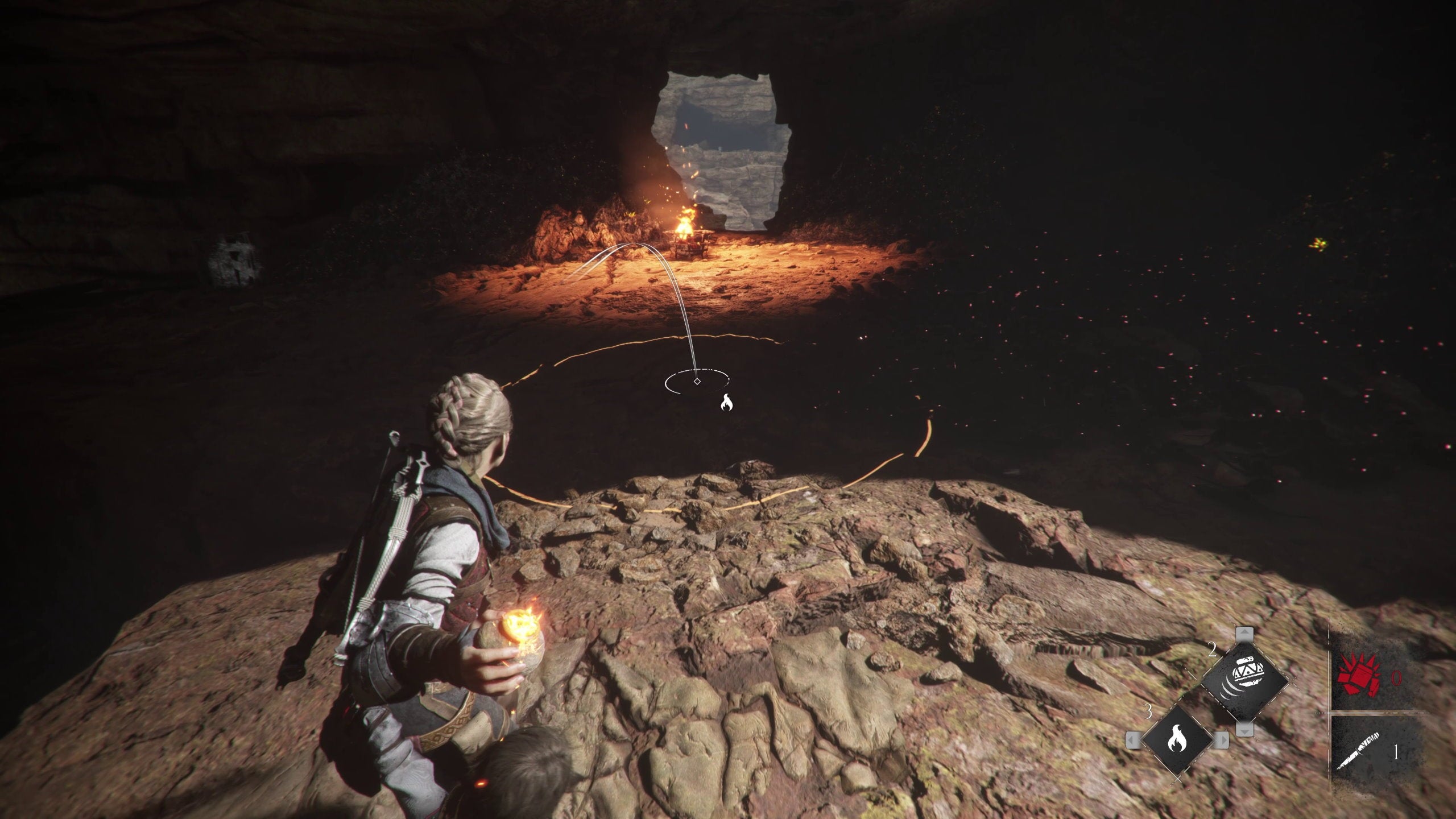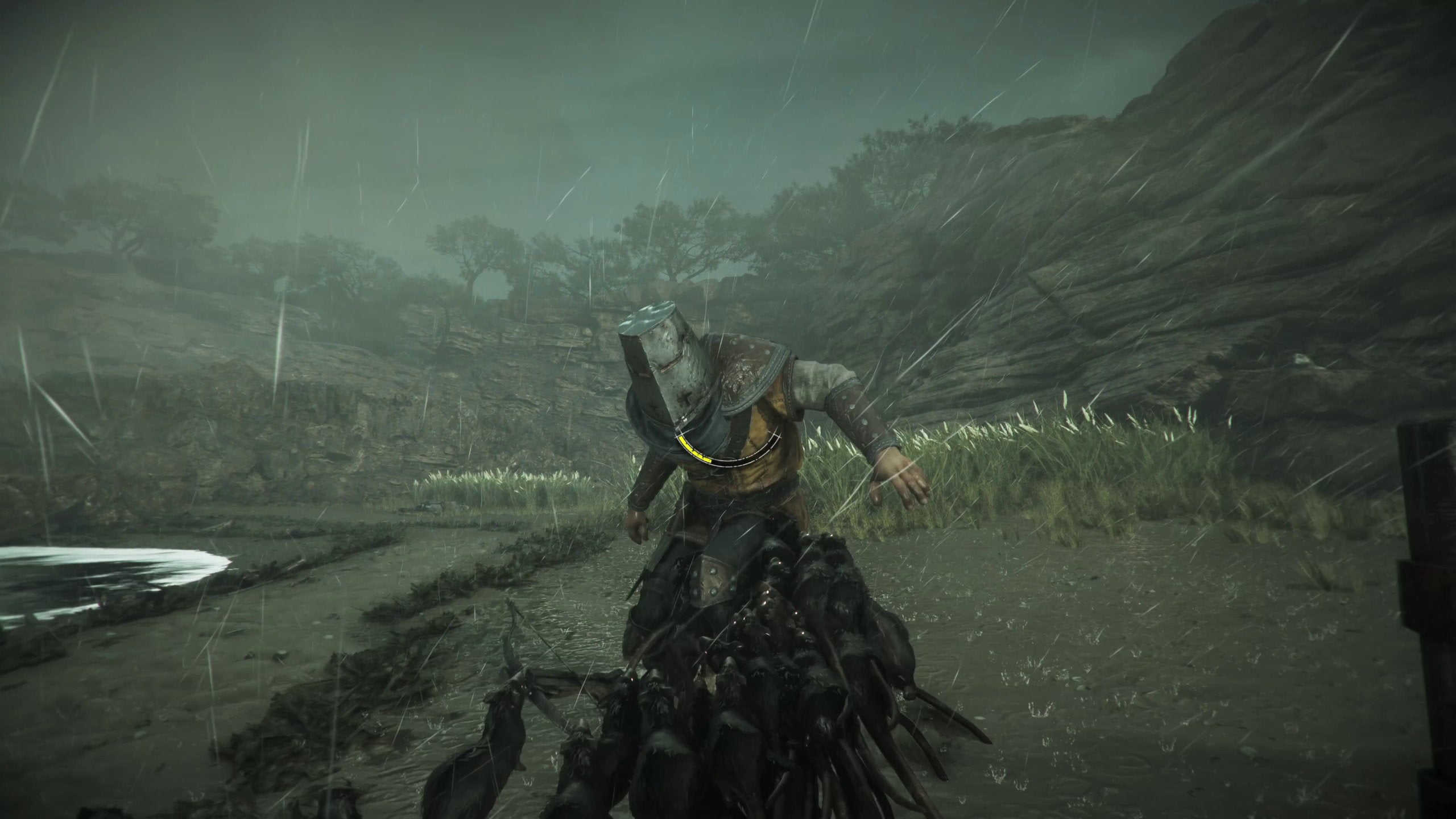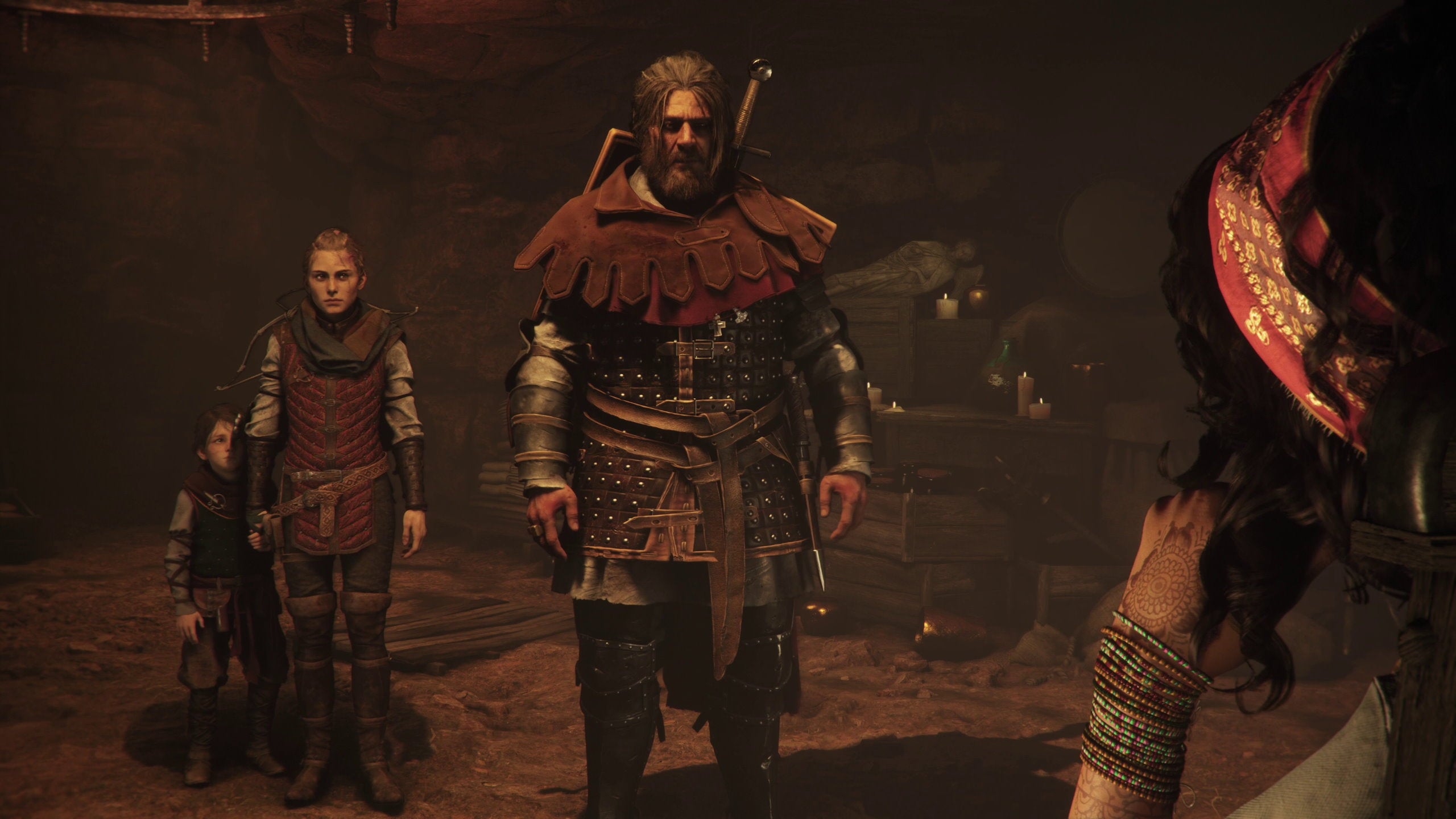Alas, when I pick up their journey in chapter six of Asobo’s upcoming sequel, A Plague Tale: Requiem, Amicia is having a particularly terrible time of it. Not only is she suffering from an open head wound, leaving her unsteady on her feet, but rumours are flying in the nearby pilgrim camp about something bad having gone down in the last city they passed through. Exactly what is hard to say with five chapters’ worth of context missing from my preview build, but the pack of guards who are hot on the siblings’ trail quickly make it plain: several men died back in that city, and they’re pointing the finger squarely at Amicia’s knife, slingshot and crossbow. As you might expect from a sequel, Amicia has a lot more tools at her disposal than she did fighting the Inquisition back in her Innocence days. In addition to the two new weapons she’s packing alongside her trusty slingshot, she’s picked up a deeper knowledge of what she can do with them, such as stabbing enemies in the back if she can get close enough, and countering grabs and lunges with space-creating punches. She’d probably make a fine apprentice to someone like Eivor or Corvo with the right kind of training, but thankfully there’s still a lingering roughness to the way she carries herself (to say nothing of poor little Hugo still stuck on her arm) that make these newfound takedowns feel like a last resort. Rather, stealth is still very much the name of the game in A Plague Tale: Requiem, but the frequency of shiny things to ding noisily with your slingshot has been significantly dialled back - at least based on what I saw during my two-and-a-half-hour demo. They’ve been replaced by slow and steady creeps through long patches of grass, crouching behind waist-high barriers, and wriggling beneath carts and rock crevices to slip through patrol patterns undetected. All fairly standard stuff by and large, but the way they’re presented feels a lot more natural, like you’re actively picking your route through these guarded danger zones as opposed to following a trail of glittering doodads. The option to distract unsuspecting enemies with rocks and pots remains, of course, but Amicia’s at least learned how to make better use of the latter. Rather than simply using them as a distraction tool in Requiem, she can now stuff them with the same alchemical recipes previously confined to her slingshot, creating wider and more potent areas of effect for her illuminating Ignifers and rat-drawing Odoris crystals. Most of these alchemy tricks will be familiar to Innocence players, but it’s heartening to see so many of them unlocked already, as the Odoris crystals in particular were a real late-game addition in Requiem’s predecessor. There’s even a brand-new one on show here - Tar - which sizzles and burns when it makes contact with an open flame, and can be used to devastating effect on heavily armoured, torch-bearing soldiers, as we soon get to see for ourselves in one of Requiem’s close-quarters boss battles. After stumbling our way through an abandoned quarry - the same one shown off during Microsoft and Bethesda’s E3 showcase a couple of months ago - a hulking great giant blocks our path. Stones and crossbow bolts are useless against his thick sheets of armour, but that fiery ball and chain he’s carrying? Now that we can work with. I fire some tar at the flames with Amicia’s slingshot, and the explosion stuns him for a few precious moments, long enough to get behind him and shoot off the latch holding his armour together. Again, it’s a similar trick to how we tackled our very first battle at the start of Innocence, but here the tight, claustrophobic nature of the arena and the sheer breadth of this screen-hogging metal man cast these familiar motions in a new, more dangerous light. With his armour peeled away, all that’s left is to drive a tar-coated crossbow bolt straight into his chest, which also catches fire in such a brutal and agonising way that it makes me wince. Maybe that was a tad unnecessary, the tar bolt. Perhaps a regular one would have been better. Indeed, the toll those deaths take on Amicia’s wellbeing is arguably greater than ever. While the first game drew several comparisons to Naughty Dog’s The Last Of Us, it seems the dev team don’t want Amicia to become just another Ellie in Requiem, immune to the horrors she inflicts on others, and you can see that debate playing out through the stilted and difficult conversations she has with her brother Hugo. He’s still a wide-eyed baby compared to his battle-hardened sister, but he too isn’t the innocent he once was, and the more questions he asks about what happened - both in the city and to all these soldiers on their tail - the harder Amicia has to work to justify her actions. It’s a conversation that carries over to the next chapter in my preview build, too, signalling that Requiem, as you might have guessed from its subtitle, will be taking a more reflective, solemn tone towards its escalating levels of violence. It’s one that Hugo will have to reckon with as well, as his macula-induced rat powers are starting to mature. A new ability he acquires in the quarry, for example, allows him to sense the blood flowing in the veins of nearby enemies, giving him a Batman-like detective vision to help them spot incoming threats. Another lets Hugo go full rat, allowing him to control the horde directly through a first-person perspective to swallow up any guard stupid enough to come out without a lantern. It’s gruesome, but wonderfully so - though this long-awaited power fantasy also comes at a cost. The first few times Hugo needs to take control the rats to defend an increasingly woozy Amicia, you can do so freely, taking as long as you want to swirl and undulate through the environment in your shrieking wave of death. But just as Amicia cries out for Hugo not to get lost in his own nightmare, the tiny chap gets overwhelmed and ends up unleashing a veritable tidal wave of rats that threatens to gobble up not onyl him, but the injured sister he’s trying to protect as well. From that point on, Hugo has a stress meter you’ll need to take into account when using his powers, creating yet another obstacle to discourage players from dipping down to a rat’s eye view too often. Some might argue what’s the point of adding new powers in the first place if the game doesn’t want us to use them, but personally I think this show of restraint is infinitely more preferable to a wanton Last Of Us or Assassin’s Creed-style murder fest. By having these kinds of limitations in place it makes each use of these powers feel more significant than your other, run of the mill abilities, and the fact that they’re so bone-crunchingly horrible in their execution also serves to underline the heft of their impact. These are not pleasant or satisfying means to an end. Efficient, yes, but they sure don’t sit easily. Like Innocence, though, Requiem knows when to step down from its moral high horse and give players a reprieve from the increasing awfulness of Hugo and Amicia’s situation. Amicia’s somewhat frayed condition in these demo chapters meant there weren’t tons of moments for lighthearted levity, but Asobo still managed to work in a smattering of them to break up the tension. As well as his keen interest in flowers, Hugo now takes extra delight in collecting stray bird feathers, and his childlike glee and curiosity remains undimmed amid the chaos. He can still be a bit of a brat at times, much to Amicia’s increasing dismay, but he remains a playful little sod you want to protect. The game itself is also just infinitely richer and more colourful to the eye, and even the grim, stormy, rain-drenched coastline they find themselves sculking through toward the end of my demo is punctuated by flashes of yellow, white and red clothing worn by guards in the distance. Accompanying them on this weather-beaten beach is newcomer Arnaud, a lone knight on the run who clearly has some previous beef with Amicia (and may or may not have given her that nasty head wound that caused her so much trouble). Tempers are constantly on edge when he’s around, but over time even Amicia sees that he’s quite the capable Hugo-handler when her efforts to rein her overexcited brother in prove wanting. They settle into an uneasy alliance over the course of this second (or rather seventh) chapter, and after a particularly nasty run-in with a swarm of rats in an infested sea cove, Arnaud agrees to battle alongside them and share the burden of combat. Essentially, he’s a bigger, badder version of Rodric from the first Plague Tale, capable of fighting soldiers on his own with his sword and shield, as well as acting as a handy crank-turner for puzzles when Amicia’s needed elsewhere for a bit of platforming. Yet again, it all feels very Innocence-like. But Arnaud quickly shows he’s so much more than just another Rodric-shaped hole to be directed as Amicia pleases. He’s an adult for starters, and a highly effective killing machine, providing a well-observed foil for Amicia in the eyes of her brother. A knight is romantic and brave and daring, after all, but will Hugo ever be able to square Arnaud’s actions with those of his sister? There seemed to be hints of a few cogs turning behind his wide, saucer-like eyes during my demo, but whether Requiem will push this point further remains to be seen. I hope it does, as everything else I saw in my demo points toward a team who have taken great care over how these characters have matured over the course of their journey. It would be a shame if Asobo didn’t interrogate these themes more deeply in Requiem’s later chapters, and an absolute travesty if these strong foundations end up as nothing more than a prelude to a knock-off Assassin’s Creed. I mean, the first game ended up with you fighting a rat pope, so it’s not beyond the realms of possibility, is all I’m saying. Still, I’m hopeful Asobo will deliver on what they’ve shown here in these (presumably) middle chapters of A Plague Tale: Requiem. It has everything you’d possibly want from a capable sequel – a wider selection of powers that build effectively on what came before, and enough twists and ripples on its familiar rhythms so it still feels new and challenging. Heck, they’ve even tidied up the crafting menu and added a Skyrim-style skill set that unlocks extra perks and buffs just by doing an action repeatedly, rewarding stealth and aggressive playstyles equally. It’s a textbook bit of sequelcraft, in other words, and I’m excited to see what lies beyond these stormy waters when A Plague Tale: Requiem launches in full on October 18th.




